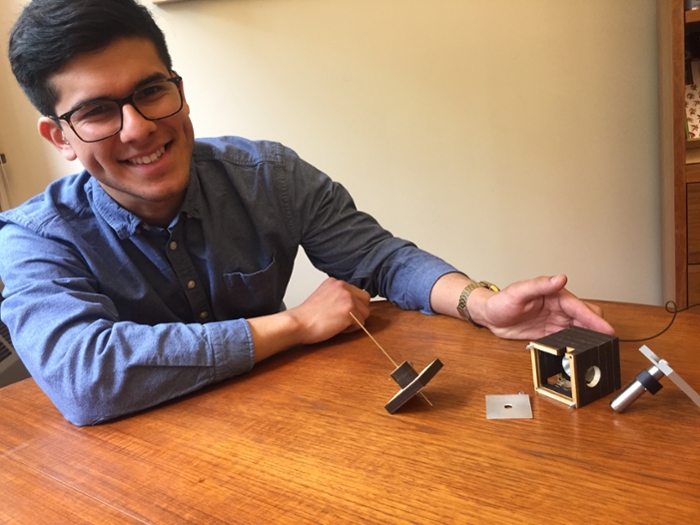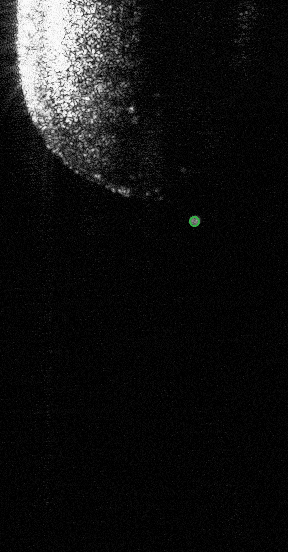
IRIS login | Reed College home Volume 96, No. 2: June 2017
Physics Major Traps Chaos in a Jar

Edgar Perez ’17 is the first researcher to observe chaotic behavior in a monopole ion trap, which he designed and built for his thesis. His project was honored with the illustrious Class of ’21 Award.
Hovering between two electrically charged spheres, the microscopic ball zigs and zags with giddy abandon, dashing hither and yon in seemingly random motion. To physics major Edgar Perez ’17, however, this intricate dance represents something beautiful—chaos, captured in a jar.
The jar is actually a monopole ion trap, and he is the first researcher to show that it can generate chaotic behavior, which he demonstrated in a series of experiments for his senior thesis.
”I’m very, very happy,” says Edgar, who won the Class of ’21 Award, recognizing “creative work of notable character, involving an unusual degree of initiative and spontaneity,” for the project.
Contrary to popular opinion, chaos is not the same as randomness—not to physicists, at least. In chaotic systems, simple, nonlinear forces give rise to monstrously complex behavior—behavior so complex that it becomes impossible to predict. Furthermore, tiny fluctuations in one part of the system can lead to massive changes in another, a phenomenon commonly known as the butterfly effect. The weather is one example of a chaotic system; the stock market another. However, chaos is not disorder. Instead, Edgar calls it “overwhelmingly intricate.”
Pioneered by French mathematician Henri Poincaré, the theory of chaos has philosophical and practical implications. In the nineteenth century, physicists believed that a universe governed by physical laws was fundamentally predictable. But the existence of chaos implies that the universe can be at once deterministic and unpredictable.
Edgar got excited about chaos and nonlinear dynamics during his junior year. For his senior thesis, he wanted to see if he could demonstrate chaotic behavior inside a monopole ion trap, a device widely used in experimental physics (including antimatter confinement at CERN). With the help of the physics machinist Jay Ewing ’97, he designed and built his own trap, which consists of two charged surfaces— a spherical rod and a bowl. Between the surfaces, he placed an electrically charged polyethylene ball, just 50 microns in diameter, roughly the width of a human hair. Electricity tends to repel the ball, so by varying the charge on the two surfaces, he could push and pull it back and forth. Edgar calculated the right charges to make the ball oscillate in midair, and learned that by tweaking alternating voltage between the surfaces he could make the ball zigzag chaotically, like a fruitfly buzzing around a bottle.

CHAOS CAPTURED. The tiny plastic ball zips back and forth between two charged surfaces in a monopole ion trap.
All through the spring, he fine-tuned his experiment, using the physics department’s high-speed camera, shooting up to 12,000 frames per second, to capture the motion of the ball, and then applying sophisticated mathematical tests to determine whether the motion was indeed chaotic. The crucial moment arrived late one night in April, deep in the sub-basement of the physics building, where his office was tucked away. “Once the data has been extracted from the images, it takes a few minutes for my code to analyze the motion. So, I hit ‘run’ and waited.” he says. “Three minutes later, the graphs popped up, and I thought ‘Oh my gosh, it worked!’ I couldn’t really move for a few moments. I was too excited.”
A first-generation student from southern California, Edgar and his family have survived some tough times. He learned how to use a soldering iron from his father and earned cash in high school by fixing ipods and other electronic gadgets for his classmates and teachers.
He chose Reed because of its focus on the life of the mind. “I realized that money comes and goes,” he says. “The only real security you can have comes from knowledge.”
At Reed, he fell in love with physics, and took practically every course the department offered.
For his thesis, he was honored with the Class of ’21 Award, recognizing “creative work of notable character, involving an unusual degree of initiative and spontaneity.” The award was also given to theatre major Ashlin Hatch ’17.
Prof. John Essick [physics], his thesis advisor, called it “the ideal physics thesis, consisting of interesting experimental findings explained by well-developed theory. This project was conceived by Edgar himself and yielded its remarkable results as a result of his drive and talent for working in open-ended environment.” Prof. Essick was so impressed that he plans to work with Edgar to submit the results in the American Journal of Physics.
In the fall, Edgar will spend a year working with high-precision clocks at the National Institute of Standards and Technology in Boulder, Colorado, in the lab of Ian Coddington ’98, before pursuing a PhD in applied physics at the University of Michigan.
Reed has an outstanding science program. Students and alumni regularly capture national awards, including 169 National Science Foundation (NSF) fellowships to date. Reed appears in the top five colleges in the nation in producing graduates who go on to earn PhDs in science and math. Science grads hunt for black holes, develop flood-resistant rice, discover new treatments for depression, and go on to many other adventures.


LATEST COMMENTS
steve-jobs-1976 I knew Steve Jobs when he was on the second floor of Quincy. (Fall...
Utnapishtim - 2 weeks ago
Prof. Mason Drukman [political science 1964–70] This is gold, pure gold. God bless, Prof. Drukman.
puredog - 1 month ago
virginia-davis-1965 Such a good friend & compatriot in the day of Satyricon...
czarchasm - 4 months ago
John Peara Baba 1990 John died of a broken heart from losing his mom and then his...
kodachrome - 7 months ago
Carol Sawyer 1962 Who wrote this obit? I'm writing something about Carol Sawyer...
MsLaurie Pepper - 8 months ago
William W. Wissman MAT 1969 ...and THREE sisters. Sabra, the oldest, Mary, the middle, and...
riclf - 10 months ago